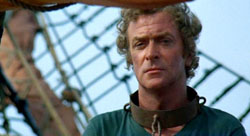
 One of the precious few genre films made by Japan’s Shochiku production studio, The Living Skeleton is a good one. The ghost story begins aboard the Dragon King, a ship carrying gold bullion, which makes it a natural to be robbed by a gang of ugly-mugged, well-armed pirates. It is, and one of its passengers, the young woman Yoriko (Kikko Matsuoka, Bushido), is raped and killed.
One of the precious few genre films made by Japan’s Shochiku production studio, The Living Skeleton is a good one. The ghost story begins aboard the Dragon King, a ship carrying gold bullion, which makes it a natural to be robbed by a gang of ugly-mugged, well-armed pirates. It is, and one of its passengers, the young woman Yoriko (Kikko Matsuoka, Bushido), is raped and killed.
Three years later, Yoriko’s identical-twin sister, Saeko (also played by Matsuoka), has an uncanny feeling that her sibling is still alive. She believes it so strongly that her fiancé (Yasunori Irikawa, Samurai Spy) accompanies her to scuba-dive at the spot of Yoriko’s would-be watery grave. There, they discover a number of skeletons floating together, chained at the ankle bones — the film’s most memorable image. Then things get weird.
 The Living Skeleton represents the lone directorial outing of Hiroshi Matsuno, which is world cinema’s loss because he proved himself quite adept at the camera. Several shots within the black-and-white picture impress with innovation even by the standards of today, especially those starkly framed by the sunglasses of the lead pirate, one side of whose face looks to have burnt into strips of jerky.
The Living Skeleton represents the lone directorial outing of Hiroshi Matsuno, which is world cinema’s loss because he proved himself quite adept at the camera. Several shots within the black-and-white picture impress with innovation even by the standards of today, especially those starkly framed by the sunglasses of the lead pirate, one side of whose face looks to have burnt into strips of jerky.
Although occasionally too dark (in lighting, not subject matter), the mood created by Matsuno makes up for budgetary shortcomings most evident in the use of rubber bats and toy boats. Be forewarned of an uncharacteristically jazzy score that blares! blares! blares! as shocks appear onscreen; Matsuno’s odd revenge tale of the supernatural — or is it? — comes prepackaged with plenty, so get used to hearing it. —Rod Lott










